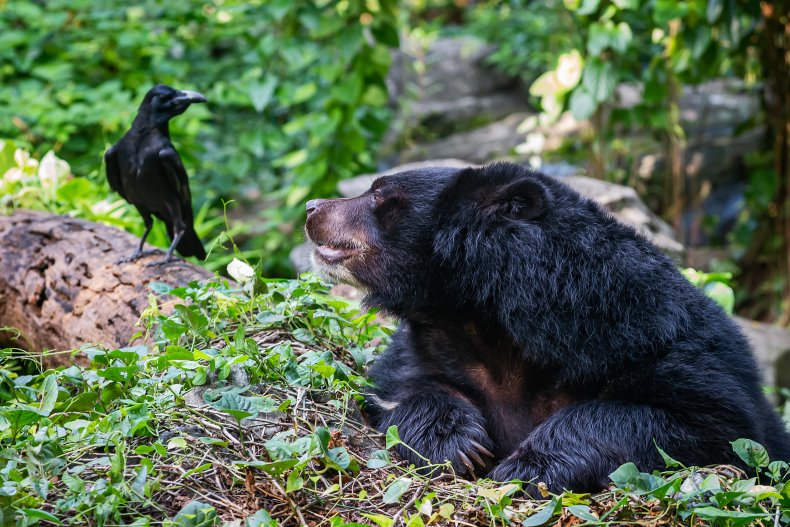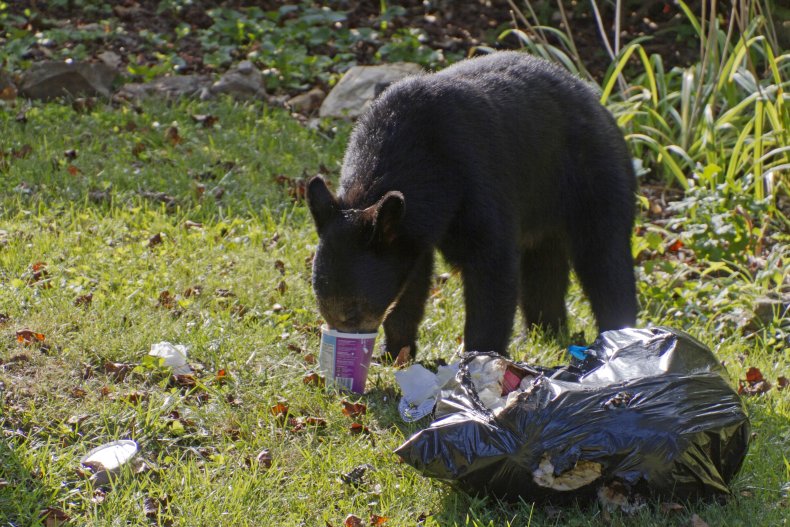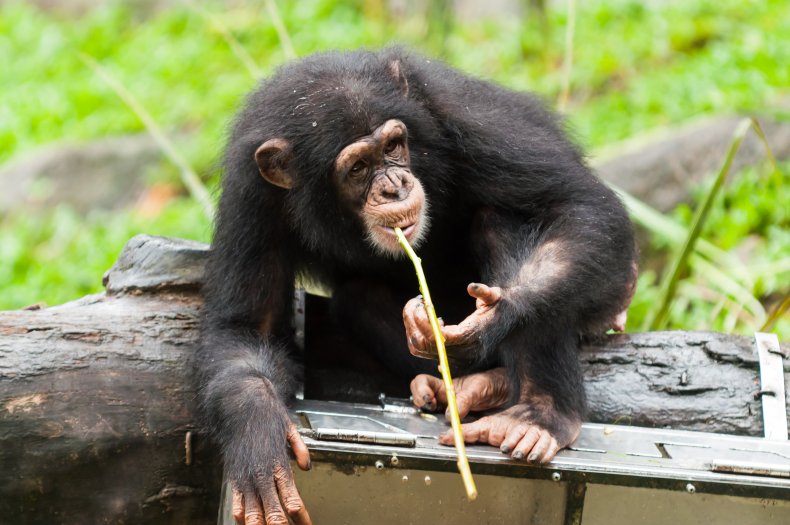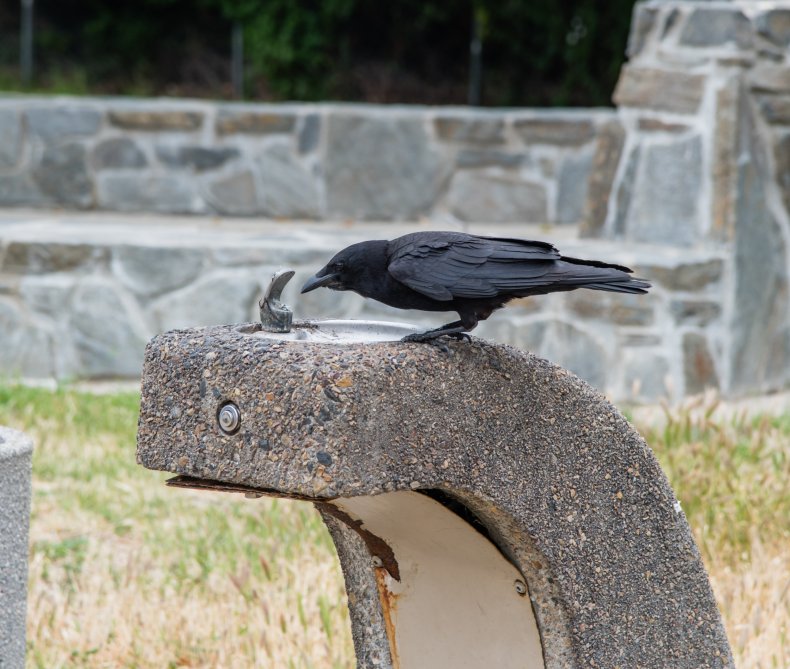BY JESS THOMSON ON 10/8/23
NEWSWEEK
When we think of intelligent animals, species like chimpanzees, dolphins and crows spring to mind, due to their charismatic behavior.
There may, however, be another unexpected animal climbing the ranks of intelligent creatures—bears.
Recent research has found that some bear species are capable of using tools to get their food—with one polar bear being spotted using a block of ice to batter a seal—a trait usually only associated with the upper echelons of intelligent animals.
"There are basically two types of intelligence, practical and social," Chris Newman, an ecology researcher at the University of Oxford's Wildlife Conservation Research Unit, told Newsweek. "Socially intelligent animals generally live in groups and this is often linked to the type of food they eat."

When we think of intelligent animals, species like chimpanzees, dolphins and crows spring to mind, due to their charismatic behavior.
There may, however, be another unexpected animal climbing the ranks of intelligent creatures—bears.
Recent research has found that some bear species are capable of using tools to get their food—with one polar bear being spotted using a block of ice to batter a seal—a trait usually only associated with the upper echelons of intelligent animals.
"There are basically two types of intelligence, practical and social," Chris Newman, an ecology researcher at the University of Oxford's Wildlife Conservation Research Unit, told Newsweek. "Socially intelligent animals generally live in groups and this is often linked to the type of food they eat."

A file photo of an Asian black bear and a raven, an established intelligent species. Bears are possibly more intelligent than we first thought.
Some animals hunt together, forming social groups to share food, rather than hoarding individually. Alternatively, practical intelligence is often linked to dexterity and the ability to manipulate the environment.
"Among mammals, this is a feature of climbing species that can grip things with their climbing 'hands' and have a hip anatomy that allows them to stand bipedally for a while to use their hands," Newman said. "Obviously, primates exemplify this sort of practical intelligence, as well as social intelligence, and can even use opposable thumbs to handle tools.
"Various climbing rodents are quite smart too, such as the crafty ways squirrels overcome bird-feeder defenses. Another smart critter is the raccoon, with very dexterous hands and a propensity to form social groups under the right condition - minimally mother and offspring groups. Even Caledonian crows will use tools in their beaks. Ultimately, dexterity and tool use can lead to complex problem solving, more sophisticated tool use and even an appreciation of mechanics, as it did in our own hominid ancestry."
While bears are independent creatures, living and hunting alone, except when caring for their cubs, they are highly specialized and capable of thriving within their environments, and they have been found to use rudimentary tools in recent years.
READ MORE
Orca attacks on boats may be fueled by revenge
Macaque monkeys frequently have gay sex
Dogs have observational spatial memory like humans, scientists confirm
Dolphins smash into "monster" school of salmon in wild footage
Captive Dolphin Dies From Lung Infection on Las Vegas Strip at Just 19
"They (or their recent ancestors in the case of polar bears) climb, and thus can stand upright and do clever things with their forepaws," Newman explains. "Where bears really do excel though is in their olfactory abilities. They can sniff out a carcass or a seal under the ice, or a backpack with a chocolate bar in it from miles away. When you combine this with their enormous strength, this is a formidable package - for instance all those stories of bears breaking into cars."
Experiments by Jennifer Vonk, a comparative psychologist at Oakland University, found that black bears are also capable of learning the difference between concepts, such as primates and non-primates, and animals and landscapes. Additionally, they were able to link the number of objects seen in an animal to real-life numbers: for example, they could learn that three almonds in a picture corresponded to receiving three almonds in real life.
"I do think bears are amongst the most flexible and clever species but there is so much we don't know," Vonk told Newsweek. "For example, we know very little about their social cognition - how they read others' intentions and emotions."
Macaque monkeys frequently have gay sex
Dogs have observational spatial memory like humans, scientists confirm
Dolphins smash into "monster" school of salmon in wild footage
Captive Dolphin Dies From Lung Infection on Las Vegas Strip at Just 19
"They (or their recent ancestors in the case of polar bears) climb, and thus can stand upright and do clever things with their forepaws," Newman explains. "Where bears really do excel though is in their olfactory abilities. They can sniff out a carcass or a seal under the ice, or a backpack with a chocolate bar in it from miles away. When you combine this with their enormous strength, this is a formidable package - for instance all those stories of bears breaking into cars."
Experiments by Jennifer Vonk, a comparative psychologist at Oakland University, found that black bears are also capable of learning the difference between concepts, such as primates and non-primates, and animals and landscapes. Additionally, they were able to link the number of objects seen in an animal to real-life numbers: for example, they could learn that three almonds in a picture corresponded to receiving three almonds in real life.
"I do think bears are amongst the most flexible and clever species but there is so much we don't know," Vonk told Newsweek. "For example, we know very little about their social cognition - how they read others' intentions and emotions."

A file photo of a black bear eating trash out of a garbage bag.
It's very difficult to compare intelligence across different species, however, which is a roadblock for scientists attempting to classify animals based on how smart they are.
"Most researchers who work on animal cognition don't like the word 'intelligence,' as it implies we would have standardized tests that would work for all species, reduce their cognition to some score, and compare it to human intelligence to make ourselves feel superior," Ivo Jacobs, a researcher in cognitive zoology at Lund University, told Newsweek. "Instead, we're simply interested in how animal minds work, no matter how smart or stupid. A species that performs well on one task, does not necessarily perform well on another, which also makes it hard to rank them."
Some traits that are basic to one animal may be perceived as a sign of intelligence in another, but these abilities are based strongly on the animal's natural environment and what they need to do to survive.
"If you put a stake in the ground and tie a dog's line to it, they will eventually wrap around a tree (if within range) and become hopelessly entangled," Tom S. Smith, a professor of wildlife sciences at Brigham Young University, told Newsweek. "Do the same with a squirrel and it quickly untangles the line and is free once again.
"Is the squirrel more intelligent than the dog? Looking objectively at these two species, dogs live in a two-dimensional world... whereas squirrels in a three dimensional world (trees). Squirrels have to solve problems like this all the time, whereas dogs don't. If that were some sort of IQ test it would be giving the impression that squirrels are smarter, but of course the tests are biased."
It's very difficult to compare intelligence across different species, however, which is a roadblock for scientists attempting to classify animals based on how smart they are.
"Most researchers who work on animal cognition don't like the word 'intelligence,' as it implies we would have standardized tests that would work for all species, reduce their cognition to some score, and compare it to human intelligence to make ourselves feel superior," Ivo Jacobs, a researcher in cognitive zoology at Lund University, told Newsweek. "Instead, we're simply interested in how animal minds work, no matter how smart or stupid. A species that performs well on one task, does not necessarily perform well on another, which also makes it hard to rank them."
Some traits that are basic to one animal may be perceived as a sign of intelligence in another, but these abilities are based strongly on the animal's natural environment and what they need to do to survive.
"If you put a stake in the ground and tie a dog's line to it, they will eventually wrap around a tree (if within range) and become hopelessly entangled," Tom S. Smith, a professor of wildlife sciences at Brigham Young University, told Newsweek. "Do the same with a squirrel and it quickly untangles the line and is free once again.
"Is the squirrel more intelligent than the dog? Looking objectively at these two species, dogs live in a two-dimensional world... whereas squirrels in a three dimensional world (trees). Squirrels have to solve problems like this all the time, whereas dogs don't. If that were some sort of IQ test it would be giving the impression that squirrels are smarter, but of course the tests are biased."

file photo of a chimpanzee using tools to get fruit from a box. They are among animals we know to be highly intelligent.
Therefore, while tool use is a hallmark of intelligent species, its use by bears doesn't necessarily make them geniuses.
"Tool use is actually a very broad behavior and its associated cognition can only be inferred from proper experiments," Jacobs explains. "Tool use is also instinctual for some animals. For instance, there are insects that throw sand at prey, similar to bears throwing stones. I think it's too early to have solid conclusions about bear intelligence, but what they have shown so far is impressive."
More research needs to be done into other aspects of bear intelligence to truly realize their capacity for figuring out problems and self-awareness.
"Testing intelligence is often done by seeing if animals can comprehend differences in size and quantity (it's also a test of cognitive ability in the development of human babies)," Newman suggests. "Lots vs few / huge vs tiny is fairly easy, but which is slightly bigger is harder: Would a bear be able to discriminate whether the two large picnic hampers left on the park bench represented a greater potential food reward than the four smaller ones?"

A file photo of a crow drinking water out of the drinking fountain at the rest area in Southern California. They are considered to be highly intelligent
There may also be other highly intelligent animals flying under the radar of research that are among the smartest species in nature.
"I am sure there are species whose intelligence we can't appreciate because their minds are so different from our own and they have to solve very different problems. Many animals have not been studied - deep sea creatures being one group that are neglected for obvious reasons," Vonk said.
Jacobs agrees: "There are likely many intelligent animals that we don't know about yet. We are a small field that traditionally has focused on only some animals, particularly primates. Yet, there are many mammals, such as platypuses and marsupials, that have been tested only little or not at all on cognitive tasks. We also don't know much about the cognition of reptiles and amphibians."
"I am sure there are species whose intelligence we can't appreciate because their minds are so different from our own and they have to solve very different problems. Many animals have not been studied - deep sea creatures being one group that are neglected for obvious reasons," Vonk said.
Jacobs agrees: "There are likely many intelligent animals that we don't know about yet. We are a small field that traditionally has focused on only some animals, particularly primates. Yet, there are many mammals, such as platypuses and marsupials, that have been tested only little or not at all on cognitive tasks. We also don't know much about the cognition of reptiles and amphibians."
No comments:
Post a Comment